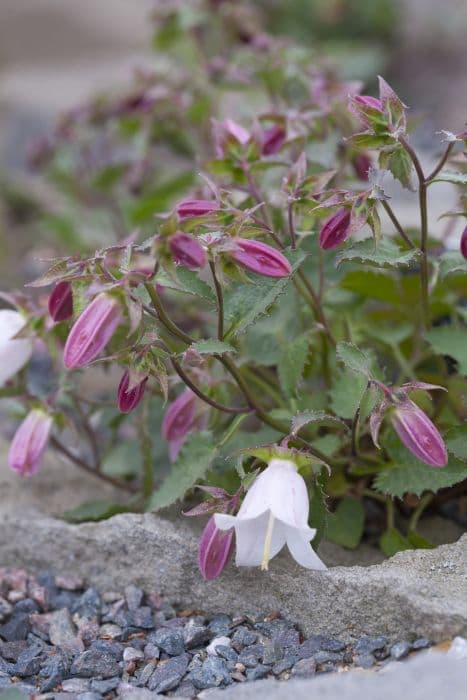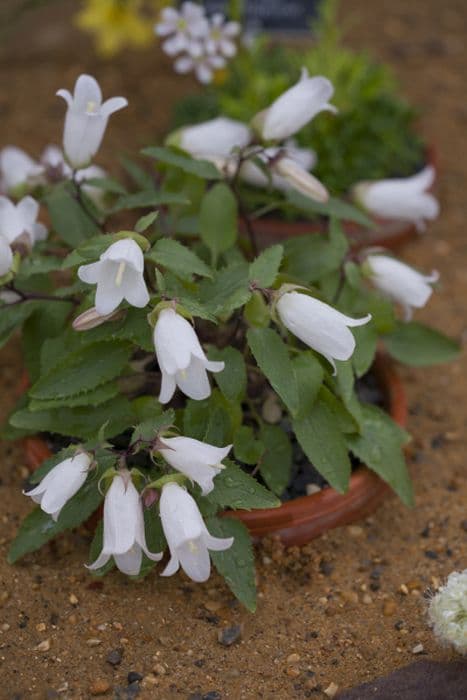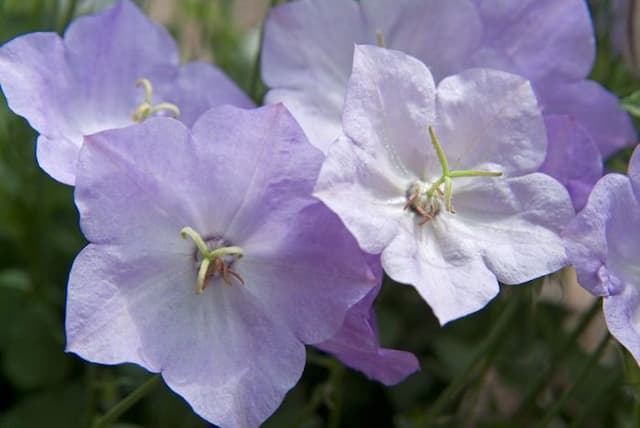Bellflower Campanula choruhensis

ABOUT
Campanula choruhensis, commonly known as the Choruh bellflower, is a perennial species that displays a captivating appearance with its distinct flowering habit. The Choruh bellflower typically bears beautiful bell-shaped flowers that have a deep blue to violet hue, creating an eye-catching display when in bloom. These blossoms are suspended on slender stalks that rise above the foliage with grace. The petals may be slightly fused at the base, forming a tube that flares open into a rounded bell shape at the mouth. The leaves of the Choruh bellflower are typically bright green, giving a fresh and vibrant look to the plant. They often have a heart-shaped base and a pointed tip, displaying a toothed or wavy edge that adds texture to the overall appearance. The foliage forms a rosette at the base of the plant, from which the flowering stalks emerge. The overall growth habit presents an elegant and delicate look, making the Choruh bellflower an attractive plant for gardens and natural landscapes. The contrast of the rich, blue-violet flowers against the greenery makes this plant particularly appealing to gardeners seeking to add a splash of cool-toned color to their floral arrangements.
About this plant
 Names
NamesFamily
Campanulaceae
Synonyms
Choruh Bellflower
Common names
Campanula choruhensis.
 Toxicity
ToxicityTo humans
Campanula, commonly known as bellflower, typically has species that are not known to be toxic to humans. However, there is no specific information available on the toxicity of Campanula choruhensis to humans. It is always best to avoid ingesting any plant parts if their toxicity is unknown or not well documented, as they may cause unexpected reactions in certain individuals. If Campanula choruhensis were to be poisonous, symptoms could potentially include gastrointestinal distress such as nausea, vomiting, or diarrhea, although this is speculative. It's important to consult medical professionals for accurate information and guidance related to plant ingestion.
To pets
Bellflower is not commonly listed as toxic to pets. However, the exact toxicity of Campanula choruhensis to animals such as cats and dogs is not clearly documented. As a general precaution, it is advised not to allow pets to ingest parts of plants that do not have a confirmed safety profile. If the plant were toxic, symptoms might include gastrointestinal upset, such as vomiting or diarrhea, or more serious symptoms depending on the plant's specific toxins. If a pet has ingested an unknown plant or is showing signs of poisoning, it is important to contact a veterinarian immediately.
 Characteristics
CharacteristicsLife cycle
Perennials
Foliage type
Deciduous
Color of leaves
Green
Flower color
Blue
Height
1-2 feet (30-60 cm)
Spread
1-2 feet (30-60 cm)
Plant type
Herb
Hardiness zones
5
Native area
Turkey
Benefits
 General Benefits
General Benefits- Aesthetic Appeal: Adds vibrant purple-blue colors to gardens and landscapes with its bell-shaped flowers.
- Pollinator Attraction: Attracts bees, butterflies, and other beneficial pollinators, supporting biodiversity.
- Ease of Care: Relatively low-maintenance plant, suitable for gardeners of all levels of experience.
- Drought Tolerance: Once established, Campanula choruhensis can tolerate periods of dryness, reducing the need for frequent watering.
- Soil Adaptability: Adapts to a wide range of soil types, although it prefers well-drained, fertile soils.
- Perennial Growth: As a perennial, it comes back each year, providing long-term value in the garden.
 Medical Properties
Medical PropertiesThis plant is not used for medical purposes.
 Air-purifying Qualities
Air-purifying QualitiesThis plant is not specifically known for air purifying qualities.
 Other Uses
Other Uses- Ground Cover: Campanula choruhensis can provide dense foliage, making it an excellent ground cover to suppress weeds in garden landscapes.
- Garden Borders: Their compact growth and bell-shaped flowers make them ideal for creating attractive border edging in flower beds and garden paths.
- Rock Gardens: This species is well-suited for rock gardens where they add texture and color to the crevices and ledges of rocky terrains.
- Container Gardening: Campanula choruhensis can be planted in pots or hanging baskets to enjoy their cascading blooms on balconies and patios.
- Fairy Gardens: Due to their modest size and enchanting appearance, they are a charming addition to fairy gardens or miniature garden projects.
- Butterfly Gardens: The flowers can attract butterflies, making them a wonderful choice for butterfly or pollinator gardens.
- Pressed Flower Crafts: The delicate flowers are suitable for pressing and can be used in various craft projects, like making bookmarks or greeting cards.
- Photography Subject: Their picturesque blossoms provide a perfect opportunity for photography enthusiasts to capture close-up images of nature.
- Education: Campanula choruhensis can be used in educational settings like schools to teach students about plant growth and horticulture.
- Green Roofing: The plant can be utilized in green roofing projects to create a living roof that helps with insulation and biodiversity.
Interesting Facts
 Feng Shui
Feng ShuiThe Bellflower is not used in Feng Shui practice.
 Zodiac Sign Compitability
Zodiac Sign CompitabilityThe Bellflower is not used in astrology practice.
 Plant Symbolism
Plant Symbolism- Endurance: Campanula choruhensis, commonly known as the Turkish Bellflower, is typically found in rugged environments, symbolizing the capacity to endure difficulties and persist through challenging conditions.
- Constancy and Permanence: The Turkish Bellflower has a perennial nature, which allows it to represent unwavering commitment or everlasting love. The plant's consistent flowering can be seen as a metaphor for steadiness in life or relationships.
- Youth and New Beginnings: This bellflower species, with its delicate blooms, is often associated with youthfulness and the start of something fresh or hopeful, reminiscent of the rejuvenating quality of springtime.
 Water
WaterBellflowers, including the Turkish bellflower (the common name for Campanula choruhensis), should be watered deeply once per week to encourage root growth. They need a thorough watering that reaches deep into the soil, amounting to around 1-1.5 gallons depending on the size of the plant and the environmental conditions. In hot and dry periods, water the plant twice a week. During the winter months or in cooler climates, reduce the frequency to every other week or when the top inch of the soil feels dry. Ensure proper drainage to avoid water logging, which can cause root rot.
 Light
LightTurkish bellflower flourishes in full sun to partial shade conditions. The best spot for this plant is in a location where it can receive at least six hours of sunlight daily. However, it should be protected from the intense afternoon sun, especially in hotter regions, to prevent scorching the leaves. An east or west-facing garden bed or window that receives gentle morning or evening light is ideal.
 Temperature
TemperatureTurkish bellflowers are hardy and can tolerate a wide temperature range, but they thrive best between 60 and 70 degrees Fahrenheit. They can survive minimum temperatures down to 30 degrees Fahrenheit but should be protected from frost. The ideal temperature range allows for healthy growth and flowering. It's essential to avoid exposure to temperatures above 80 degrees Fahrenheit for prolonged periods, as it can stress the plant.
 Pruning
PruningPruning Turkish bellflowers helps maintain their shape and encourages a more robust bloom in the next season. Prune the plant back by about one-third after flowering to promote new growth. This often occurs in late summer or early fall. Deadheading spent blooms throughout the growing season can also stimulate further flowering. The best time for major pruning is in the spring, just as new growth begins to appear.
 Cleaning
CleaningAs needed
 Soil
SoilBellflowers prefer well-draining soil with a pH range of 6.0 to 8.0. A mix of loamy soil, compost, and perlite or sand can provide the right environment for Campanula choruhensis to thrive, ensuring good drainage while retaining adequate moisture.
 Repotting
RepottingBellflowers do not need frequent repotting and can be repotted every 2-3 years. Repot Campanula choruhensis in spring to refresh the soil and accommodate growth, ensuring that the new pot is only slightly larger than the previous one to prevent water logging.
 Humidity & Misting
Humidity & MistingBellflowers, such as Campanula choruhensis, are adaptable but prefer moderate humidity levels. They generally do well in normal household humidity conditions without needing any special treatment.
 Suitable locations
Suitable locationsIndoor
Place in bright, indirect light and ensure proper drainage.
Outdoor
Choose a sunny spot with part shade and well-draining soil.
Hardiness zone
5-9 USDA
 Life cycle
Life cycleCampanula choruhensis, commonly known as Choruh bellflower, begins its life cycle as a seed, which upon germination, develops into a small seedling. The seedling stage is characterized by the appearance of the first true leaves as it uses the energy stored in the seed to establish itself. As the plant enters the vegetative stage, it grows leaves and stems, using photosynthesis to acquire energy for growth and development. Following vegetative growth, it reaches maturity and enters the flowering stage, where it produces distinctive bell-shaped flowers that attract pollinators. After successful pollination, the flowers produce fruits which contain seeds, and as the fruits mature, they release the seeds into the environment, thereby completing the life cycle. These seeds may then germinate in conducive conditions, giving rise to new Choruh bellflower plants.
 Propogation
PropogationPropogation time
Spring to Summer
The most popular method for propagating Campanula choruhensis, commonly known as the Turkish bellflower, is by seed. The best time to sow seeds is in spring after the threat of frost has passed. You would start by scattering the seeds on the surface of a moist, well-draining seed starting mix and gently pressing them into the soil without covering them, as light is needed for germination. Keep the soil lightly moist and at a temperature of about 70 degrees Fahrenheit (21 degrees Celsius). Germination typically occurs within two to three weeks. Once seedlings grow large enough to handle, they can be transplanted into individual pots and eventually into the garden after hardening off to acclimate them to outdoor conditions.









